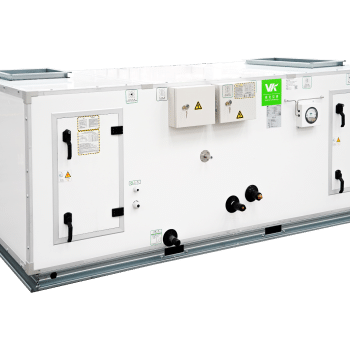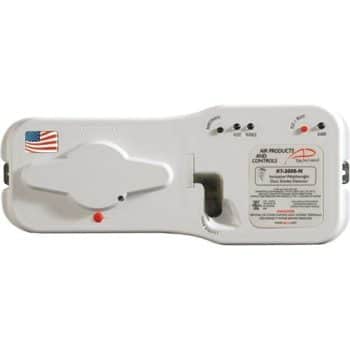
Several applications require manual reset switches, which are switches that need to be physically reset by an individual for a process to continue or restart. A manual reset is often needed when an area has to be inspected prior to equipment restart. This can help to ensure the safety/inspection of both equipment and other individuals in the area.
Some switches have a mechanical manual reset (such as the Dwyer Series 1900, 1831, and 1800). However, there may be a need to have a manual reset for applications beyond what these switches are designed for. If a pump is allowed to run with a clogged filter, for example, this may severely damage the pump.
Our Series DX differential pressure switches are a great option for filter monitoring on pumps and other liquid applications. Although these switches do not come with a manual reset from the factory, they can be programmed to create a manual reset switch using an intermediate relay. We’ll analyze how this is accomplished in the below circuit.

In this circuit, the DX pressure switch is our primary control. The 782 DPDT relay uses one pole in a latching configuration. The main power is supplied at C1 (Common 1) and C2 (Common 2) on the 782 relay. C1 will provide power for our latch function and C2 is providing power for our pump motor contactor. B2 is a normally closed contact that, under normal conditions with low differential pressure in our system, will provide power to our pump motor contactor.

Once the DX switch detects that the differential pressure is higher than the desired pressure across the filter, the DX switch changes state. This causes the 782 relay to trip, disconnecting C2’s power from the B2 starter contact. This removes power from the pump. C1’s power is fed to the A1 contact through the manual reset switch back into the coil hence creating a latch for the 782 Relay. To “unlatch” the 782, the reset button is pressed, resetting the circuit. If the DX pressure switch is still tripped due to high differential pressure, the 782 will not reset when the reset button is pressed.
If you have any questions about programming our switches, or would like to learn about any of our other products, please reach out to our website bkic.vn, or by email at info@bkic.vn.
Dwyer Instruments offers a multitude of sensors for monitoring air velocity in HVAC systems. Some of this instrumentation has a simple construction (Pitot tubes, for example) while others are more complex, such as hot-wire anemometers. The initial term and first “hot-wire anemometer” was developed back in 1914 by Louie Vesso King. He is also accredited...
Explore nowFrom dairy to petrochemicals, several applications require monitoring or control of liquids in tanks. Wastewater facilities are among the many industries requiring meticulous observation. The technology used for this measurement is dependent upon the type of tank and its contents. Capacitive level switches, for example, detect level and send a switch signal output when the...
Explore now Modular Air Handling Unit (VAC) của Veck là dòng AHU hiệu suất cao với thiết kế không khung dạng labyrinth giúp loại bỏ cầu nhiệt và tối ưu cách nhiệt. Cấu trúc module linh hoạt, bề mặt trong bo tròn, không keo dán giúp đảm bảo vệ sinh tuyệt đối, phù hợp cho bệnh viện, phòng sạch và nhà máy thực phẩm. Tích hợp khung lọc chuyên dụng, panel cách âm – cách nhiệt mật độ cao, khung vỏ kép tăng độ cứng và giảm rung, dễ dàng tùy biến theo yêu cầu công trình.
Modular Air Handling Unit
Explore now
Modular Air Handling Unit (VAC) của Veck là dòng AHU hiệu suất cao với thiết kế không khung dạng labyrinth giúp loại bỏ cầu nhiệt và tối ưu cách nhiệt. Cấu trúc module linh hoạt, bề mặt trong bo tròn, không keo dán giúp đảm bảo vệ sinh tuyệt đối, phù hợp cho bệnh viện, phòng sạch và nhà máy thực phẩm. Tích hợp khung lọc chuyên dụng, panel cách âm – cách nhiệt mật độ cao, khung vỏ kép tăng độ cứng và giảm rung, dễ dàng tùy biến theo yêu cầu công trình.
Modular Air Handling Unit
Explore now
 The RT-3000-P is a photoelectric weather tight duct smoke
detector. The weathertight, NEMA 4X rated, corrosion
resistant enclosure, coupled with extended temperature
listings, allow installation in the widest possible range of
indoor/outdoor environments.
NEMA 4x Duct Smoke Detector RT-3000-P
Explore now
The RT-3000-P is a photoelectric weather tight duct smoke
detector. The weathertight, NEMA 4X rated, corrosion
resistant enclosure, coupled with extended temperature
listings, allow installation in the widest possible range of
indoor/outdoor environments.
NEMA 4x Duct Smoke Detector RT-3000-P
Explore now
 The MINI-IP series multiprotocol I/O modules are compact remote I/O devices designed to extend building controllers over IP using open protocols such as BACnet IP and Modbus TCP/IP. They offer flexible integration with BMS, complementing the MIX I/O modules and supporting both new and existing building automation systems.
I/O Modules: MINI - IP Series - iSMA-Controlli
Explore now
The MINI-IP series multiprotocol I/O modules are compact remote I/O devices designed to extend building controllers over IP using open protocols such as BACnet IP and Modbus TCP/IP. They offer flexible integration with BMS, complementing the MIX I/O modules and supporting both new and existing building automation systems.
I/O Modules: MINI - IP Series - iSMA-Controlli
Explore now